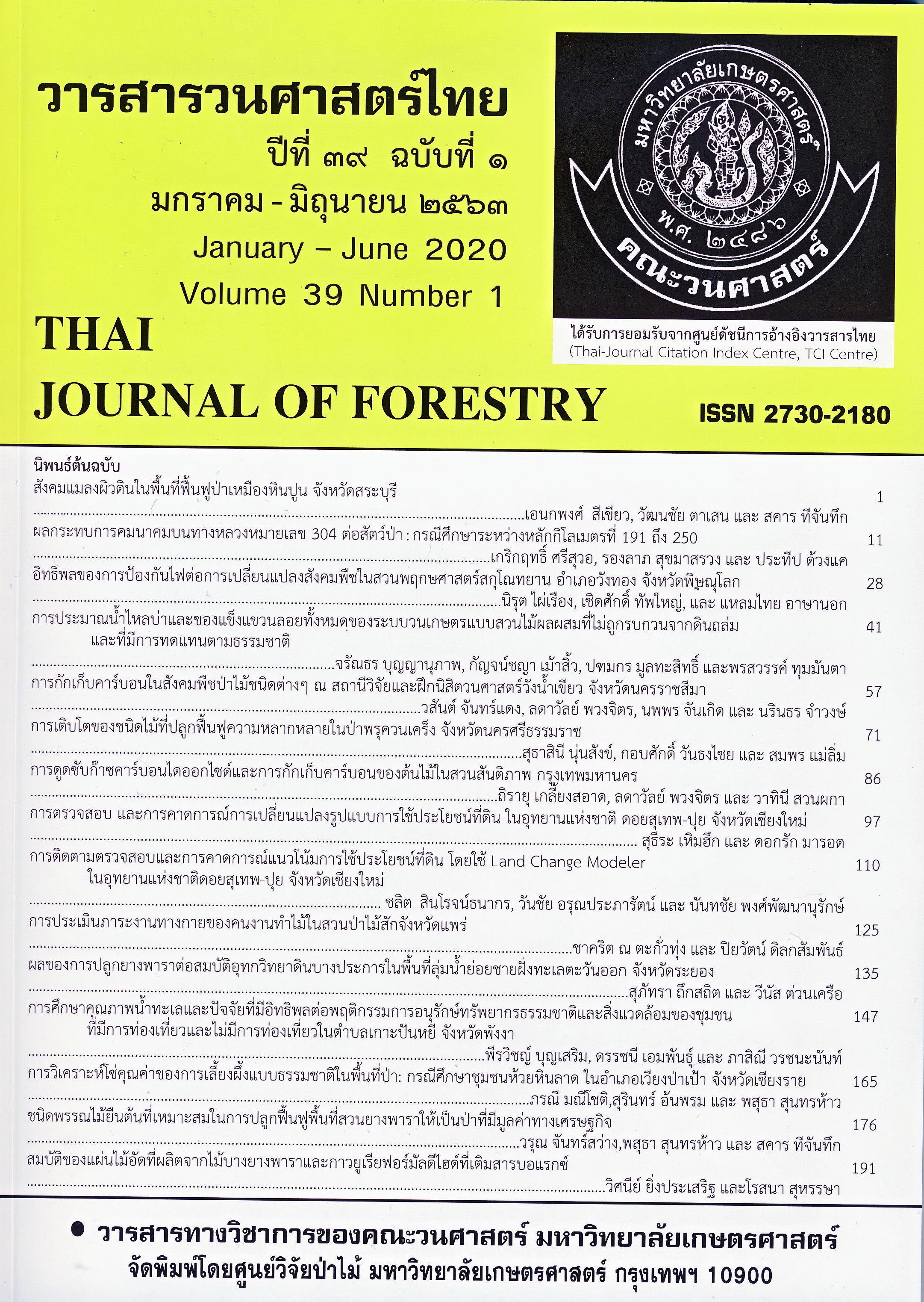การประเมินภาระงานทางกายของคนงานทำไม้ในสวนป่าไม้สักจังหวัดแพร่
Main Article Content
บทคัดย่อ
การศึกษาภาระงานทางกายของคนงานทำไม้ในสวนป่าไม้สักจังหวัดแพร่ มีวัตถุประสงค์เพื่อประเมินระดับภาระงานทางกายของงานประเภทต่างๆ ในขั้นตอนการทำไม้สัก โดยศึกษาในคนงานจำนวน 93 คน 18 ประเภทงาน ในสวนป่าวังชิ้น สวนป่าแม่สรอย สวนป่าขุนแม่คำมี และสวนป่าแม่คำปอง ขององค์การอุตสาหกรรมป่าไม้ ในพื้นที่จังหวัดแพร่ โดยใช้ข้อมูลดัชนีมวลกายและอัตราการเต้นของหัวใจในการวิเคราะห์ จากการศึกษาพบว่า คนงานมีดัชนีมวลกายอยู่ในเกณฑ์ปกติร้อยละ 67.74 น้อยกว่าปกติร้อยละ 6.45 และมากกว่าปกติร้อยละ 25.81 สำหรับค่าทางสรีรวิทยาที่เกี่ยวกับอัตราการเต้นของหัวใจ เมื่อนำมาคำนวณเป็นค่าภาระงานทางกาย พบว่า อยู่ในเกณฑ์ต่ำและปานกลาง โดยมีค่าต่างๆ ประกอบด้วย อัตราการเต้นของหัวใจขณะพักเฉลี่ยเท่ากับ 87.57 ครั้งต่อนาที อัตราการเต้นของหัวใจขณะทำงานเฉลี่ยเท่ากับ 108.73 ครั้งต่อนาที อัตราการเต้นของหัวใจสัมพัทธ์ขณะทำงานเฉลี่ยเท่ากับร้อยละ 22.52 สัดส่วนอัตราการเต้นหัวใจขณะทำงานต่ออัตราการเต้นของหัวใจขณะพักเฉลี่ยเท่ากับ 1.25 และสัดส่วนอัตราการเต้นของหัวใจขณะพักต่อค่าครึ่งหนึ่งของอัตราการเต้นของหัวใจสำรองเฉลี่ยเท่ากับ 0.75 ข้อมูลเหล่านี้สามารถนำไปใช้วางแผนในการบริหารจัดการประเภทงานให้เหมาะสมกับสมรรถนะของคนงาน เพื่อให้ได้ผลงานที่มีประสิทธิภาพ และลดปัญหาการบาดเจ็บหรืออุบัติเหตุที่เกิดจากการทำงานที่หนักเกินไป
Downloads
Article Details
ข้าพเจ้าและผู้เขียนร่วม (ถ้ามี) ขอรับรองว่า ต้นฉบับที่เสนอมานี้ยังไม่เคยได้รับการตีพิมพ์และไม่ได้อยู่ในระหว่างกระบวนการพิจารณาตีพิมพ์ลงในวารสารหรือสิ่งตีพิมพ์อื่นใด ข้าพเจ้าและผู้เขียนร่วม (ถ้ามี) ยอมรับหลักเกณฑ์และเงื่อนไขการพิจารณาต้นฉบับ ทั้งยินยอมให้กองบรรณาธิการมีสิทธิ์พิจารณาและตรวจแก้ต้นฉบับได้ตามที่เห็นสมควร พร้อมนี้ขอมอบลิขสิทธิ์ผลงานที่ได้รับการตีพิมพ์ให้แก่วารสารวนศาสตร์ คณะวนศาสตร์ มหาวิทยาลัยเกษตรศาสตร์ กรณีมีการฟ้องร้องเรื่องการละเมิดลิขสิทธิ์เกี่ยวกับภาพ กราฟ ข้อความส่วนใดส่วนหนึ่ง หรือ ข้อคิดเห็นที่ปรากฏในผลงาน ให้เป็นความรับผิดชอบของข้าพเจ้าและผู้เขียนร่วม (ถ้ามี) แต่เพียงฝ่ายเดียว และหากข้าพเจ้าและผู้เขียนร่วม (ถ้ามี) ประสงค์ถอนบทความในระหว่างกระบวนการพิจารณาของทางวารสาร ข้าพเจ้าและผู้เขียนร่วม (ถ้ามี) ยินดีรับผิดชอบค่าใช้จ่ายทั้งหมดที่เกิดขึ้นในกระบวนการพิจารณาบทความนั้น”
เอกสารอ้างอิง
Apud, E., F. Meyer, J. Espinoza, E. Oñate, J. Herrera and F. Maureira. 2016. Ergonomics and labour in forestry, pp. 3211-3310. In L. Pancel and M. Köhl, eds. Tropical forestry handbook. 2nd ed. Springer, Berlin.
Balimunsi, H.K., J.R.S. Kaboggoza, S.W. Abeli, R. Cavalli, and J. G. Agea. 2011. Working conditions and productivity of logging companies in Mafuga forest plantation, western Uganda. Journal of Tropical Forest Science 23(3): 232-238.
Caliskan, E. and S. Caglar. 2010. An assessment of physiological workload of forest workers in felling operations. African Journal of Biotechnology 9(35): 5651-5658.
Chanthalakhana, C. and K. Uecheawchankit. 2005. Research Scripture and International Publication. The Thailand Research Fund, Bangkok. (in Thai).
Eroglu, H., R. Yilmaz and Y. Kayacan. 2015. A study on determining the physical workload of the forest harvesting and nursery-afforestation workers. Anthropologist 21(1-2): 168-181.
Forest Industry Organization. 2019. Annual Report 2018. Forest Industry Organization, Bangkok. (in Thai)
Garet, M., G. Boudet, C. Montaurier, M. Vermorel, J. Coudert and A. Chamoux. 2005. Estimating relative physical workload using heart rate monitoring: a validation by whole-body indirect calorimetry. European Journal of Applied Physiology 94(1): 46-53.
Grandjean, E. 1982. Fitting the Task to the Man: An Ergonomic Approach. Taylor & Francis, London.
Hosokawa, Y. 2016. Physiological, Behavioral, and Knowledge Assessment of Runners’ Readiness to Perform in the Heat. Ph.D. Thesis, University of Connecticut.
ILO. 1998. Safety and Health in Forestry Work: An ILO Code of Practice. International Labour Office, Geneva.
Khamis, N.K., F.R. Ismail, B. Hesse, D. Schramm, N. Maas, M. Koppers, M.Z. Nuawi and B.M. Deros. 2016. Suitability of heart rate recording as physiological measures tool to determine drivers’ performance impairment: a preliminary study. Jurnal Teknologi (Sciences & Engineering) 78(6-9): 25-30.
Kirk, P.M. and M.J.M. Sullman. 2001. Heart rate strain in cable hauler choker setters in new zealand logging operations. Applied Ergonomics 32(4): 389-398.
Magagnotti, N. and R. Spinelli. 2012. Replacing steel cable with synthetic rope to reduce operator workload during log winching operations. Small-scale Forestry 11(2): 223-236.
Melemez, K. and M. Tunay. 2010. Determining physical workload of chainsaw operators working in forest harvsting. Technology 13(4): 237-243.
Miller, S. 2001. Workload Measures. National Advanced Driving Simulator, Iowa.
Royal Thai Government Gazette. 2018. Volume 36 Section 51, Page 1. (in Thai)
Suter, M.K., K.A. Miller, I. Anggraeni, K.L. Ebi, E.T. Game, J. Krenz, Y.J. Masuda, L. Sheppard, N.H. Wolff and J.T. Spector. 2019. Association between work in deforested, compared to forested, areas and human heat strain: an experimental study in a rural tropical environment. Environmental Research Letters 14 084012.
Tang, Z. 2018. Development and Evaluation of Virtual Reality Heart Rate Variability Biofeedback Application. KTH, School of Engineering Sciences in Chemistry, Biotechnology and Health (CBH), Stockholm.
Yilmaz, R., H. Eroğlu, H. Cihan and Y. Kayakan. 2013. Determination of physiological workloads of the harvesting workers: a case study from artvin, pp. 152-159. In International Caucasian Forestry Symposium. 24-26 October 2013. Artvin, Turkey.


